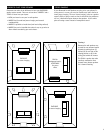
OTHER ACOUSTIC CONSIDERATIONS
For best fidelity, there are several other factors to keep in mind before
you start actual installation.
Concerns and reflections:
When an in-wall speaker is placed close to the corner of a room, bass
frequencies are emphasized. This can be okay if both speakers are
mounted near corners (while maintaining stereo imaging). But try to
avoid placing just one speaker in a corner and another on a long flat
wall.
Treble is emphasized when it reflects back from reflective surfaces
such as large windows. Conversely, highs tend to be muffled by soft
surfaces such as drapes, rugs, upholstered furniture, carpeted steps
and even textured fabric wall paper.
In general, the best acoustic performance will result if both speakers
face a similar type of surface and are placed in similar positions on
the same type of wall.
INSTALLATION DEPTH
Russound In-Wall speakers require at least 2-3/4” of wall depth
(measured from the outside surface of the wall). This means that
they can be installed in any wallboard and 2x4 stud wall. In fact, the
dense, rigid nature of plasterboard or (lath and plaster in older
homes) acts as a superb speaker baffle.
You can also install Russound speakers in stud walls covered with
thick wood paneling or in wallboard/plaster ceilings.
However, avoid:
• T-bar “drop ceilings” with very thin fiberboard panels which can
buzz and vibrate. If you suspect this will happen, reinforce the
drop-in panel with wood or particle board.
• Any wall which can’t provide proper depth (clearance) for the back
of the Russound speaker. This includes brick or concrete walls
where the wallboard or paneling is attached to thin furring strips.
• Inside wall space less than 10” wide and 48” in height
• Walls where you know that there are pipes, heating ducts and
ESPECIALLY AC wiring in the general vicinity. For example, if there
is an outlet along the baseboard, there is often a live wire running
partly up the wall at that point.
4
Drawing 2
Okay
Ideal














